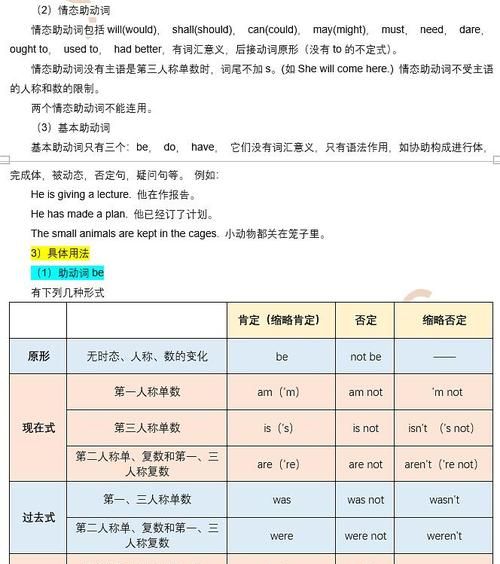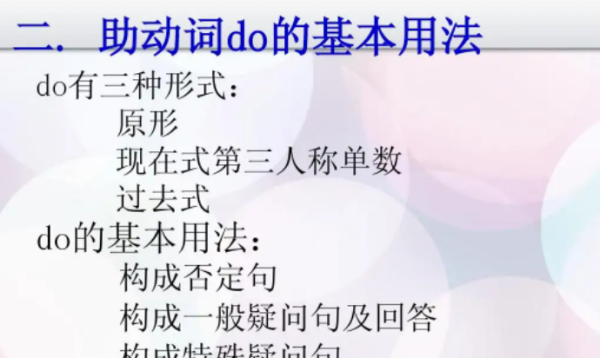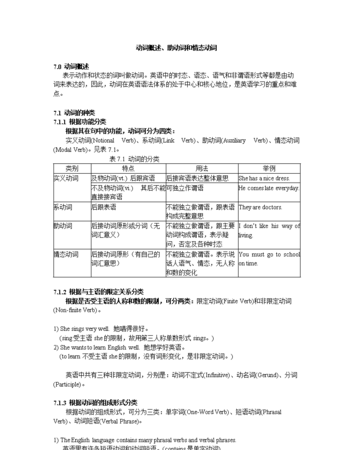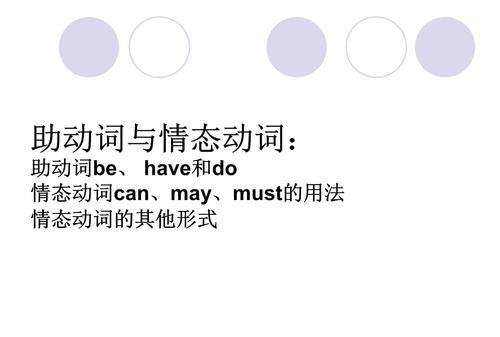本文目录
什么是助动词 有哪些用法语文
助动词本身没有词义,不可单独作句子谓语。它仅仅是用来帮助主要动词构成各种时态、语态、语气以及否定和疑问结构。协助主动词完成其谓语动词“时态”功能的词,也就是说助动词是主动词的帮手。
助动词
1)协助主要动词构成谓语动词词组的词叫助动词(Auxiliary Verb)。被协助的动词称作主要动词(Main Verb)。
助动词自身没有词义,不可单独使用,例如:
He doesn't like English.他不喜欢英语。
(doesn't是助动词,无词义;like是主要动词,有词义)
2)助动词协助主要动词完成以下功用,可以用来:
a.表示时态,例如:
He is singing.他在唱歌。
He has got married.他已结婚。
b.表示语态,例如:
He was sent to England.他被派往英国。
c.构成疑问句,例如:
Do you like college life?你喜欢大学生活吗?
Did you study English before you came here?你来这儿之前学过英语吗?
d.与否定副词not合用,构成否定句,例如:
I don't like him.我不喜欢他。
e.加强语气,例如:
Do come to the party tomorrow evening.明天晚上一定来参加晚会。
He did know that.他的确知道那件事。
3)最常用的助动词有:be, have, do, shall, will, should, would
助动词具体用法
1)协助主要动词构成谓语动词的词叫助动词。被协助的动词称作主要动词。助动词自身没有词义,不可单独使用。例如:
He doesn't like English. 他不喜欢英语。
(doesn't是助动词,无词义;like是主要动词,有词义)
2) 助动词协助主要动词完成以下功用,可以用来:
a. 表示时态。例如:
He is singing. 他在唱歌。
He has got married. 他已结婚。
b. 表示语态。例如:
He was sent to England. 他被派往英国。
c. 构成疑问句。例如:
Do you like college life? 你喜欢大学生活吗?
Did you study English before you came here? 你来这儿之前学过英语吗?
d. 与否定副词not合用,构成否定句。例如:
I don't like him. 我不喜欢他。
e. 加强语气。例如:
Do come to the party tomorrow evening. 明天晚上一定来参加晚会。
He did know that. 他的确知道那件事。
3) 最常用的助动词有:be, have, do, shall, will, should, would等。
3. 助动词be的用法
1) be +现在分词,构成进行时态。例如:
They are having a meeting. 他们正在开会。
English is becoming more and more important. 英语现在越来越重要。
2) be + 过去分词,构成被动语态。例如:
The window was broken by Tom.. 窗户是汤姆打碎的。
English is taught throughout the world. 世界各地都教英语。
3) be + 动词不定式,可表示下列内容:
a. 表示最近、未来的计划或安排。例如:
He is to go to New York next week.. 他下周要去纽约。
We are to teach the freshmen. 我们要教新生。
说明: 这种用法也可以说成是一种将来时态表达法。
b. 表示命令。例如:
You are to explain this. 对此你要做出解释。
He is to come to the office this afternoon. 要他今天下午来办公室。
c. 征求意见。例如:
How am I to answer him? 我该怎样答复他?
Who is to go there? 谁该去那儿呢?
d. 表示相约、商定。例如:
We are to meet at the school gate at seven tomorrow morning. 我们明天早晨7点在校门口集合。
4. 助动词have的用法
1)have +过去分词,构成完成时态。例如:
He has left for London. 他已去了伦敦。
By the end of last month, they had finished half of their work. 上月未为止,他们已经完成工作的一半。
2)have + been +现在分词,构成完成进行时。例如:
I have been studying English for ten years. 我一直在学英语,已达十年之久。
3)have +been +过去分词,构成完成式被动语态。例如:
English has been taught in China for many years. 中国教英语已经多年。
5. 助动词do 的用法
1)构成一般疑问句。例如:
Do you want to pass the CET? 你想通过大学英语测试吗?
Did you study German? 你们学过德语吗?
2)do + not 构成否定句。例如:
I do not want to be criticized. 我不想挨批评。
He doesn't like to study. 他不想学习。
In the past, many students did not know the importance of English.
过去,好多学生不知道英语的重要性。
3) 构成否定祈使句。例如:
Don't go there. 不要去那里。
Don't be so absent-minded. 不要这么心不在焉。
说明: 构成否定祈使句只用do,不用did和does。
4)放在动词原形前,加强该动词的语气。例如:
Do come to my birthday party. 一定来参加我的生日宴会。
I did go there. 我确实去那儿了。
I do miss you. 我确实想你。
5)用于倒装句。例如:
Never did I hear of such a thing. 我从未听说过这样的事情。
Only when we begin our college life do we realize the importance of English. 进了大学以后,我们才认识到英语的重要性。
说明: 引导此类倒装句的副词有never, seldom, rarely, little, only, so, well等。

助动词的用法
英语中常见的助动词有do、does、did、have、has、would、should、will、be、shall等。助动词大体上可以划分为三类,一是半助动词,它介于助动词和一般动词之间,主要有have to、be about to、be able to、be going to、be due to、seem to、be likely to、be meant to、be obliged to、be supposed to、be willing to等。
基本助动词,分别是be、do、have以及它们的变形格式。比如,I have finish the homework.助动词只是辅助动词共同构成谓语的,本身没有实际含义。

助动词种类较多,以下主要介绍be,do,will,have等助动词的使用:
一、be动词作助动词。 由连系动词am,is,are构成的句子:变一般疑问句时把am,is,are提到句子的前面,句尾用问号即可。变否定句时直接在am,is,are后面加not即可。
2、was 是am,is的过去式,were是are的过去式,若句子中有以上两词时,变疑问句及否定句方法与be相同。
英语助动词有哪些
学习英语的时候要注意语法和一些词的用法,下面我就为大家整理一下助动词有哪些。
英语中常见的助动词包括:
1.行为动词类:do, does, did
1. 现在进行时态中的be动词:am, is , are ,
2. 过去进行时态中的be动词:was, were
3. 一般将来时态中的助动词:shall, will,
4. 现在完成时态助动词: have, has
5. 过去完成时态助动词:had
6. 情态动词类:can, may, must, should, could, would, might, have/has to, used to,
7. 被动语态助动词:be 的各种时态.
情态动词与助动词
1、can
能,可以,表说话人同意,许可还可表客观条件许可,如:You can go now.
提建议或请求时可用can I, can you表客气,如Can I buy you a drink?
2、may
(1)可以,表说话人同意,许可或请求对方许可。You may go.
(2)(现在和将来)可能,也许,只用于肯定句和否定句中,如He may not be right.
3、must, have to
must表主观上的必须,have to表客观上的必须,如: It's getting late. I have to go. -Must I go now. -Yes, you must. (No, you needn't./ No, you don't have to.)
4、need, dare这二词有实意动词和情态动词两种词性,如用作实意动词后接动词不定式to do,如用作情态动词后接动词原形。Need I go now? --Yes, you must./No, you needn't.)
5、shall用于第一人称疑问句中表说话人征求对方的意见或向对方请求,如,Shall we begin our lesson?
用于二、三人称陈述句,表说话人命令、警告、允诺、威胁等口吻,如: You shall fail if you don't work harder.
6、should表应该,意为有责任,有义务。如:We should try our best to make our country more beautiful.
7、will表有做某事的意志、意愿、安心、打算,如 "Will you lend me your book?" "Yes, I will."
8、should have done表应该做而未做
must have done表对过去事实的肯定推测
could have done表本可以做某事
9、判断句:肯定句用must, 否定句用can't, 不太肯定用may, might
He must be in the office now.
He must have gone to bed, for the light is out.
He can't be in the office. He is at home.
He couldn't have cleaned the classroom, because he didn't come here today.
He might be in the office, I am not sure.
He might have cleaned the room, I suppose.

助动词的用法
助动词的用法:1、表示时态,He is singing. 他在唱歌;2、表示语态,如:He was sent to England. 他被派往英国;3、构成疑问句,如:Do you like college life?你喜欢大学生活吗;4、与否定副词not合用,构成否定句,如:I did not (=didn't )like him. 我不喜欢他。5、加强肯定或祈使语气。
最常用的助动词有:be, have/has, do/does/did , shall, should, will, would等。助动词可以协助主要动词构成时态或者语态,也可构成疑问句和否定句,构成否定句时与否定副词not连用。助动词可以分为半助动词、情态助动词和基本助动词。
助动词的分类:
半助动词
在功能上介于主动词和助动词之间的一类结构,称为半助动词。常见的半助动词有:be to, be about to, be due to, be going to, be likely to, be meant to,be obliged to, be supposed to, be willing to, have to, seem to,be unable to, be unwilling to. 等。
情态助动词
情态助动词包括will(would), shall(should), can(could), may(might), must, need, dare, ought to, used to, had better,有词汇意义,后接动词原形(没有to的不定式)。两个情态助动词不能连用。
基本助动词
基本助动词只有三个:be, do, have, 它们没有词汇意义,只有语法作用,如协助构成进行体,完成体,被动态,否定句,疑问句等。

以上就是关于助动词有哪些以及用法 ,什么是助动词 有哪些用法语文的全部内容,以及助动词有哪些以及用法 的相关内容,希望能够帮到您。
